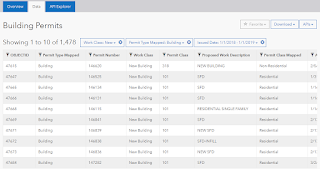Parks, Recreation and Cultural Resources Open Data
Last year, some of my colleagues and I in Parks, Recreation
and Cultural Resources (PRCR) began work on updating our parks and greenway
trails data. We fixed typos, cleaned up some inconsistencies, and did our best
to ensure that our data reflected our department’s actual inventory of park
properties and greenway trails. However, during this process we discovered
several datasets named some variation of "Parks" and "Greenway
Trails". All differed in minor ways and none matched what we had come up
with for our update. Simply updating our data was not enough.
Over the past few months I've had the pleasure of working
with the City's Enterprise GIS and Enterprise Data Anlaytics groups to address
how both staff and the public access the department's authoritative spatial
data. In that time we’ve been developing and instituting changes in workflows,
data storage, and best practices to ensure staff and the public are working
from the same data. The latest updates to Raleigh
Parks and Raleigh
Greenway Trails are the culmination of this initial effort.
If you've used the parks and greenways datasets in the past,
there are two major changes to be aware of. First, we've fully moved our parks
and greenways data to ArcGIS Online. In the past, you could access these
dastasets via ArcGIS Online, but at the end of the day, they were served from a
City or Raleigh server. Now the data are served from ArcGIS Online's cloud
service platform. As a result, there are new endpoints for accessing the data
via the GeoService and GeoJSON APIs. If you have an application that pulls
parks or greenway trails via these APIs, you'll want to make sure you update
the endpoint.
Second, Greenway Trails and Greenway Structures have been
consolidated into a single dataset: Raleigh Greenway Trails. These had
previously been separated to accommodate needs specific to the City’s asset
management software. That need for separation hasn't changed, but it no longer
drives how our greenway trails data is made available to staff or the public.
By taking advantage of hosted
feature layer views in ArcGIS Online we can tailor the same data to
accommodate a wider variety of needs. If you've been using the Greenway Trails
and Greenway Structures datasets in your application, you'll only need to use
the Raleigh Greenway Trails dataset moving forward.
With this major update comes a renewed sense of possibility
about how these data might be used. I've put together a few simple examples
showing how the Raleigh Parks and Raleigh Greenway Trails datasets might be
integrated into a data analysis or visualization project. These examples
represent starting points. I can't wait to see what you all come up with!
Examples
Greenway Elevation Profiler
This example enables users to create interactive elevation
profiles of segments from the Raleigh Greenway Trails. This is a no-code
application based on ArcGIS Online’s Elevation
Profile web app template. Create an ArcGIS
for Developers account to get started adding Raleigh Open Data to maps and
apps.
Greenway Buffer Analysis
What areas are within 1 mile of a greenway trail? Using the esri-leaflet JavaScript library
to access Raleigh Greenway Trails and passing the data through a few of TurfJS’s spatial analysis functions, we can
determine what areas are within 1 mile of a Raleigh Greenway and what areas are
not.
Embed Code
>
Park Development Status
This example relies on the ArcGIS for JavaScript API 4.x
and Raleigh Parks dataset to generate an interactive thematic map focused on
the development status of properties in PRCR’s inventory.
Embed Code
Nearest Park Analysis
This example relies on two datasets from the Raleigh Open
Data site: Raleigh Parks and Planning Jurisdictions. The latter is made
available on Raleigh Open Data by Wake County. Behind the scenes, this example
uses the extent of Raleigh’s planning jurisdiction and TurfJS to create a grid
of .25x.25 mile squares. For each of those squares TurfJS calculates the
distance to center of the nearest park. While this analysis draws on two
datasets available via Raleigh Open Data, the result is an entirely new
dataset.
Embed Code
"See the Pen Straight-line
Distance to Center of Nearest Developed Raleigh Park by RaleighPRCR
(@RaleighPRCR) on
CodePen."
Written by: Ryan Cooper







Comments
Post a Comment